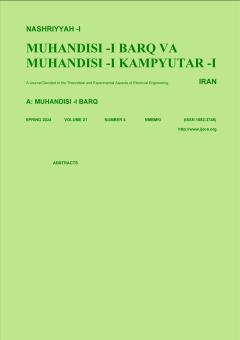Wide Area out of Step Prediction of Interconnected Power System Using Decision Tree C5.0 Based on WAMS Data
Subject Areas : electrical and computer engineering
1 - Velayat University
Keywords: Transient instability, out-of-step, power swing, prediction, decision tree C5.0, WAMS,
Abstract :
This paper presents a new method for Out-of-Step detection in synchronous generators based on Decision Tree theory. For distinguishing between power swing and out-of-step conditions a series of input features are introduced and used for decision tree training. For generating input training samples, a series of measurements are taken under various faults including operational and topological disturbances. The proposed method is simulated over 10 machines 39-bus IEEE test system and the simulation results are prepared as input-output pairs for decision tree induction and deduction. The merit of proposed out-of-step protection scheme lies in adaptivity and robustness of input features under different input scenarios
[1] S. Ranjbar, "Online estimation of controlled islanding time intervals using dynamic state trajectories through cascading failures from WAMS data," Electric Power Systems Research, pt A, vol. 214, Article ID: 108890, Jan. 2023.
[2] J. Qi, Q. Wu, Y. Zhang, G. Weng, and D. Zhou, "Unified residue method for design of compact wide-area damping controller based on power system stabilizer," J. of Modern Power Systems and Clean Energy, vol. 8, no. 2, pp. 367-376, Mar. 2020.
[3] Q. Mou, H. Ye, and Y. Liu, "Nonsmooth optimization-based WADC tuning in large delayed cyber-physical power system by interarea mode tracking and gradient sampling," IEEE Trans. on Power Systems, vol. 34, no. 1, pp. 668-679, Jan. 2019.
[4] M. J. Alinezhad, M. Radmehr, and S. Ranjbar, "Adaptive wide area damping controller for damping inter-area oscillations considering high penetration of wind farms," International Trans. on Electrical Energy Systems, vol. 30, no. 3, pp. 622-633, Mar. 2020.
[5] S. Ranjbar, "Adaptive criteria of estimating power system separation times based on inter‐area signal," IET Generation, Transmission & Distribution, vol. 17, no. 3, pp. 573-588, Feb. 2023.
[6] M. Bento, "Fixed wide-area damping controller considering time delays and power system operation uncertainties," IEEE Trans. on Power Systems, vol. 35, no. 5, pp. 3918-3926, Sep. 2020.
[7] A. Thakallapelli and S. Kamalasadan, "Wide-area damping of inter-area oscillations based on MIMO identification," IET Generation, Transmission & Distribution, vol. 14, no. 13, pp. 2464-2475, Aug. 2020.
[8] J. L. Rodríguez-Amenedo and S. A. Gómez, "Damping low-frequency oscillations in power systems using grid-forming converters," IEEE Access, vol. 9, pp. 158984-158997, 2021.
[9] Y. Zhou, J. Liu, Y. Li, C. Gan, H. Li, and Y. Liu, "A gain scheduling wide-area damping controller for the efficient integration of photovoltaic plant," IEEE Trans. on Power Systems, vol. 34, no. 3, pp. 1703-1715, May 2019.
[10] I. Zenelis, X. Wang, and I. Kamwa, "Online PMU-based wide-area damping control for multiple inter-area modes," IEEE Trans. on Smart Grid, vol. 11, no. 6, pp. 5451-5461, Nov. 2020.
[11] Y. Shen, W. Yao, J. Wen, and L. Jiang, "Resilient wide-area damping control using GrHDP to tolerate communication failures," IEEE Trans. on Smart Grid, vol. 10, no. 3, pp. 2547-2557, May 2019.
[12] N. R. Naguru and V. Sarkar, "Practical supplementary controller design for the bi-layer WAC architecture through structurally constrained H2 norm optimisation," IET Generation, Transmission & Distribution, vol. 13, no. 7, pp. 1095-1103, Mar. 2019.
[13] L. Simon, K. S. Swarup, and J. Ravishankar, "Wide area oscillation damping controller for DFIG using WAMS with delay compensation," IET Renewable Power Generation, vol. 13, no. 1, pp. 128-137, Apr. 2019.
[14] F. Wilches-Bernal, R. H. Byrne, and J. Lian, "Damping of inter-area oscillations via modulation of aggregated loads," IEEE Trans. on Power Systems, vol. 35, no. 3, pp. 2024-2036, May 2020.
[15] X. Shi, Y. Cao, M. Shahidehpour, Y. Li, X. Wu, and Z. Li, "Data-driven wide-area model-free adaptive damping control with communication delays for wind farm," IEEE Trans. on Smart Grid, vol. 11, no. 6, pp. 5062-5071, Nov. 2020.
[16] T. Surinkaew, R. Shah, M. Nadarajah, and S. M. Muyeen, "Forced oscillation damping controller for an interconnected power system," IET Generation, Transmission & Distribution, vol. 14, no. 2, pp. 339-347, 2020.
[17] N. Naguru and Y. Ganapavarapu, "Design of a limited state feedback wide-area power system damping controller without communication channels," IEEE Access, vol. 8, pp. 160931-160946, 2020.
[18] G. N. Baltas, N. B. Lai, L. Marin, A. Tarrasó, and P. Rodriguez, "Grid-forming power converters tuned through artificial intelligence to damp subsynchronous interactions in electrical grids," IEEE Access, vol. 8, pp. 93369-93379, 2020.
[19] S. Ranjbar, M. R. Aghamohammadi, and F. Haghjoo, "A new scheme of WADC for damping inter-area oscillation based on CART technique and thevenine impedance," International J. of Electrical Power and Energy Systems, vol. 94, pp. 339-353, Jan. 2018.
[20] M. Sarkar, B. Subudhi, and S. Ghosh, "Unified smith predictor-based H∞ wide-area damping controller to improve the control resiliency to communication failure," IEEE/CAA J. of Automatica Sinica, vol. 7, no. 2, pp. 584-596, Mar. 2020.
[21] J. A. Oscullo and C. F. Gallardo, "Residue method evaluation for the location of PSS with sliding mode control and fuzzy for power electromechanical oscillation damping control," IEEE Latin America Trans., vol. 18, no. 1, pp. 24-31, Jan. 2020.

